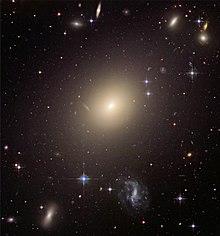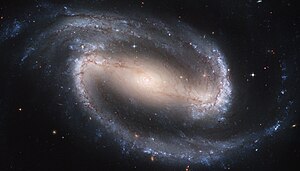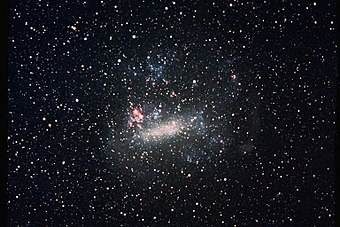Galaxy is a system of stars, dust and gas held together by gravity. Galaxies are the building blocks of our solar system. Our solar system is in a galaxy called the Milky Way galaxy. Scientists estimate that there are more 100 billion galaxies scattered throughout the visible universe then just think how many more might be there. Astronomers have photographed millions of them through telescopes. The most distant galaxies are as far as 10 billion to 13 billion light years away. Galaxies range in diameter over a few thousand to a half-million light years. Small galaxies have fewer than a billion stars. Large galaxies have more than a trillion.
Galaxies are distributed unevenly in space. Some have no close neighbour. Others occur in pairs, with each orbiting the other. But most of them are found in groups called clusters. A cluster may contain from a few dozen galaxies to several thousand galaxies.
Classification of galaxies:
Galaxies are classified under their shape
1
)Spiral galaxies: Galaxies that are shaped like spirals contain new and old stars. Spiral galaxies are identified by their curved arms, which form a spiral around their center. Some of the biggest and the best known galaxies are spirals, like our own Milky Way Galaxy and the great Andromeda Galaxy.
 |
| Spiral Galaxy |
2)
Elliptical galaxies: Elliptical Galaxies are
made up of ancient stars. Some elliptical Galaxies are flat like pancakes, while others are round
 |
| Elliptical Galaxy |
3)
Irregular Galaxy: Some galaxies have no particular shape. They may look like a twisted saucer or an odd shaped ball. These are irregular galaxies.
.jpg/220px-Irregular_galaxy_NGC_1427A_(captured_by_the_Hubble_Space_Telescope).jpg) |
| Irregular Galaxy |
4)
Lenticular galaxies: A galaxy which is an intermediate between an elliptical galaxy and a spiral galaxy are know as Lenticular galaxies. They are disk galaxies, like spiral galaxies but contain very small amount of interstellar dust, thus having very little amount of star formation.
 |
| Lenticular Galaxy |
5)
Barred spiral galaxies:
 |
| Barred Spiral Galaxy |
The Milky Way Galaxy: Milky Way galaxy is the galaxy in which we live. The solar system is situated in this galaxy. The solar system in fact rotates around the milky way galaxy once in every 1,250,000 years. Huge clouds of gas and dust lie through out the galaxy and form new stars everyday. The milky way is so humongous that 10 other small galaxies orbit around it like the planets revolve around the sun.
 |
The core of the Milky way galaxy
Infrared Image |
The milky way is shaped like a thin disk with a bulge in the center. The bulge consists of a vast, thick bar of stars. Stars, dust, gas fan out from the central bulge in long, curving arms that form a spiral(coiled) pattern. Astronomers believe that the spiral patterns originate from the ends of the bar. Therefore, they classify Milky Way as a barred spiral galaxy. Barred spirals are a common type of galaxy, though not as common as spiral galaxies without bars.
.jpg/250px-Andromeda_Galaxy_(with_h-alpha).jpg) |
| Andromeda Galaxy |
The Andromeda Galaxy: The Andromeda Galaxy is a spiral galaxy approximately 2.6 million years away. The Andromeda can be seen from the
North Pole. The Andromeda galaxy was thought to be bigger than the milky way but it has been proved wrong in the year 2006. It is as huge as the Milky way Galaxy is. The Andromeda gets its name from the Andromeda constellation.
 |
A picture of Andromeda by
NASA |
The Milky Way galaxy and the Andromeda are heading towards each other slowly. They are expected to collide in about 4.5 billion years creating a massive explosion in the universe.
.jpg/300px-Small_Magellanic_Cloud_(Digitized_Sky_Survey_2).jpg) |
| Small Magellanic Cloud |
 |
| Large Magellanic Cloud |
From the
Southern hemisphere two more Galaxies can be seen with the naked eye. They are called as the
Large Magellanic Cloud and the
Small Magellanic Cloud. Both are Irregular Galaxies. They are 160,000 and 180,000(approximately) light years away from the milky way.
Cannibal Galaxies: These types of Galaxies are not special divisions, but these are special types of humongous galaxies. These Galaxies are also called the Hungry galaxies. They are so big that they swallow up their neighbouring small galaxies.Even the Milky way is believed to be a Cannibal Galaxy which will in time swallow
Sagittarius, a small neighbouring galaxy.
 |
| Sagittarius Galaxy |


.jpg/220px-Irregular_galaxy_NGC_1427A_(captured_by_the_Hubble_Space_Telescope).jpg)



.jpg/250px-Andromeda_Galaxy_(with_h-alpha).jpg)

.jpg/300px-Small_Magellanic_Cloud_(Digitized_Sky_Survey_2).jpg)







.jpg/300px-NGC_4414_(NASA-med).jpg)



0 comments:
Post a Comment